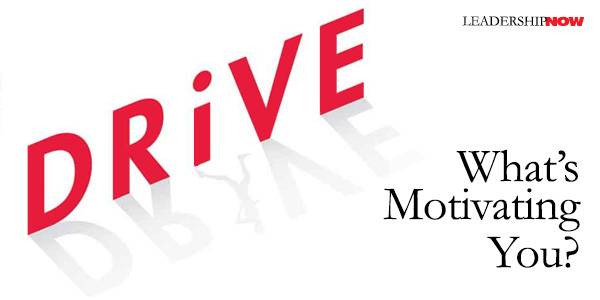 |
 |
02.05.10

Drive: What’s Motivating You?
WHEN it comes to motivation, I think we can all agree on one thing: People are motivated in different ways—often surprisingly different ways—at different times depending on their needs, wants, desires, philosophy, age, friends, status, values, circumstances, background, mood, attitude, insecurities, self-absorption, and a number of things I left out for the sake of brevity. Obviously, when it comes to motivation, one size doesn’t fit all, best practices don’t work across the board, and our approaches to motivation must begin with respect. In Drive, Dan Pink defines three types of motivational operating systems or assumptions about how humans behave from which a motivational construct can be created: Motivation 1.0 presumes that humans are biological creatures, struggling for survival.Motivation 2.0 presumes that humans also respond to rewards and punishments in their environment. It seeks compliance. Motivation 3.0 presumes that humans also have a third drive—to learn, to create, and to better the world. It seeks engagement. Listed the way they are, it is tempting to think of this as a historical progression moving from the base world of the caveman to the enlightened world of today. In fact, these types of motivation have been with us throughout history, however today we are blessed with the opportunity to contemplate Motivation 3.0 on a scale that was never before possible. And we should. The most important point Pink makes is that we still use Motivation 2.0 as a fallback motivational construct for almost any situation we encounter—and most often to our detriment. Stating the problem, he writes: Too many organizations—not just companies, but governments and nonprofits as well—still operate from assumptions about human potential and individual performance that are outdated, unexamined, and rooted more in folklore than in science. They continue to pursue practices such as short-term incentive plans and pay-for-performance schemes in the face of mounting evidence that such measures usually don’t work and often do harm. Worse, these practices have infiltrated our schools, where we ply our future workforce with iPods, cash, and pizza coupons to ‘incentivize’ them to learn. Something has gone wrong. Something has gone wrong—or—maybe has never really been sufficiently addressed. Carrot-and-stick motivators are much easier to implement than intrinsic motivators. Who has the time? But as work changes—“more complex, more interesting, and more self-directed”—intrinsic motivation is going to be a much larger, pressing concern to leaders. But, I think it would be wrong to assume that Motivation 1.0 and 2.0 are no longer of any consequence. We must recognize that people are at different places at different times in their lives. A person could even prefer Motivation 2.0 for their own 3.0 reasons. Extrinsic motivators have their place in many situations, especially when time is an issue. Although extrinsic motivators may be hit-or-miss, they often get the job done and they are fairly easy to implement in an even-handed way. The problem is that they are overused and often used exclusively. Extrinsic motivators are grounded in short-term thinking and will not provide lasting results. Unfortunately, we do create systems and workplaces that encourage behavior driven by extrinsic motivation that doesn’t satisfy our need for meaning. Extrinsic motivators will never give employees the autonomy, mastery and purpose that Pink calls for. Nor are they really designed to do that. They simply influence short-term behavior to a desired end. There are times when Pink’s research leads to overreaching conclusions, but his basic argument that we are designed to be “autonomous, self-determined, and connected to one another” and that “when that drive is liberated, people achieve more and richer lives” is a sound one. As he suggests, we should try to move people and work to a Motivation 3.0 construct that fosters what he terms Type I behavior. Type I behavior is “a way of thinking and an approach to life built around intrinsic, rather than extrinsic, motivators. It is powered by our innate need to direct our own lives, to learn and create new things, and to do better by ourselves and our world.” The last third of the book is a toolkit for fostering more Type I behavior. There are practical suggestions for the workplace, but some of his best suggestions are for parents and educators. If some of these ideas were put into practice, we would probably turn out more engaged kids, with critical thinking skills and a life-long love for learning. In all, Pink makes a good case for the adoption of Motivation 3.0 based on the widely accepted fact that work that makes us feel in control of our lives is better than work that doesn’t. Some work has the potential to do that and some work never really will. But, if Drive raises our awareness and causes us to re-examine how we are motivating people (or not) and the effects of the systems we create, then it will have made a serious contribution to making our organizations a better place to work and helping people to fulfill their potential. 
Posted by Michael McKinney at 07:38 AM
|
BUILD YOUR KNOWLEDGE
 

How to Do Your Start-Up Right STRAIGHT TALK FOR START-UPS 
Grow Your Leadership Skills NEW AND UPCOMING LEADERSHIP BOOKS 
Leadership Minute BITE-SIZE CONCEPTS YOU CAN CHEW ON 
Classic Leadership Books BOOKS TO READ BEFORE YOU LEAD |